
The Holland Tunnel is a highway tunnel under the Hudson River connecting the island of Manhattan in New York City with Jersey City, New Jersey at Interstate 78 on the mainland. The tunnel was originally known as the Hudson River Vehicular Tunnel or the Canal Street Tunnel and is one of two highway tunnels under the Hudson River (the Lincoln Tunnel is the other).
http://en.wikipedia.org/wiki/Holland_Tunnel
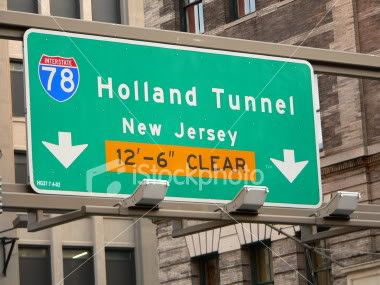
Holland Tunnel
http://www.answers.com/topic/holland-tunnel?cat=technology
The Holland Tunnel is a highway tunnel under the Hudson River connecting the island of Manhattan in New York City with Jersey City, New Jersey at Interstate 78 on the mainland.
The tunnel was originally known as the Hudson River Vehicular Tunnel or the Canal Street Tunnel and is one of two highway tunnels under the Hudson River (the Lincoln Tunnel is the other).
Begun in 1920 and completed in 1927, it is named after Clifford Milburn Holland (1883 - 1924), Chief Engineer on the project, who died before it was completed. (Famed tunnel designer Ole Singstad finished Holland's work.) The tunnel is one of the earliest examples of a ventilated design, having 80 ft (24 m) diameter fans blowing air in one series of ducts and out another series. Ventilation was required by the advent of the automobile and associated exhaust.
The tunnel consists of a pair of tubes, each providing two lanes in a twenty foot roadway width. The north tube is 8,558 ft (2,608 m) from end to end, while the south tube is slightly shorter at 8,371 ft (2,551 m). Both tubes are situated in the bedrock beneath the river, with the lowest point of the roadway approximately 93 feet (28 m) below mean high water. A nine-lane toll plaza equipped with E-ZPass is located on the New Jersey side of the tunnel. As of 2003, the charge for passage from New Jersey to New York is $6 for cars and $5 for motorcycles (there is no toll in the opposite direction). According to the Port Authority of New York and New Jersey, which controls the tunnel, traffic for 2002 totalled 15,764,000 vehicles, 33,926,000 vehicles in 2004, and 33,964,000 vehicles in 2005. The Tunnel was designated a National Historic Landmark in 1993 (Structure #93001619).
History
The concept for what would become the Holland Tunnel was developed in 1906 by a joint commission between New York and New Jersey. The commission initially considered building a bridge for cost reasons, but this plan was abandoned in favor of a tunnel in 1913 when it was determined that the cost of land for accessways to a suitably raised bridge would be prohibitive (a height of 200 feet (60 m) was considered the minimum necessary to avoid interfering with shipping.)
Over the next several years, a number of design proposals were evaluated for the new tunnel. The first two called for a single tube containing two levels of traffic. One, authored by engineer George Goethals specified that traffic on each level would travel in a different direction. The other, by the firm Jacobs and Davies, called for a slightly different tube diameter, with an "express" level and a level for slower traffic. Both designs were eventually passed over in favor of a new type of design proposed by engineer Clifford Milburn Holland, in which two separate tubes would each contain two lanes both going in the same direction. Holland's proposal was adopted, and he was named Chief Engineer of the project.
Work on the tunnel, officially designated the "Hudson River Vehicular Tunnel Project", began in October 1920. In 1924, the day before the two halves of the tunnel were scheduled to be linked, 41-year-old Holland died during a tonsillectomy at a health center in Battle Creek, Michigan. Holland was succeeded by Milton H. Freeman, who also died after several months on the job. After Freeman's death, the position was occupied by Ole Singstad, who oversaw the completion of the tunnel and designed its pioneering ventilation system.
Tunnel construction required workers to spend large amounts of time under high pressure, which was necessary to prevent river water from entering prior to completion of the tubes. "Sandhogs", as they were termed, entered the tunnel through a series of airlocks, and could only remain inside of the tunnel for a designated time period. On exiting the tunnel, the workers were required to undergo controlled decompression in order to avoid the bends, a condition in which nitrogen bubbles form in the blood. Fortunately, no workers died as a result of decompression.
Completion of the tunnel took nearly seven years, and the lives of fourteen workers. Opened on November 13, 1927, the tunnel was an immediate success. On its first day of operation, 51,694 vehicles passed through, each paying a 50 cent toll, which was intended to defray the tunnel's $48 million price tag. In 1931 the tunnel was passed to the Port Authority of New York and New Jersey, which continues to operate it today. Excluding the initial $48 million in construction, the Port Authority notes $536,600,000 of cumulative capital investment as of December 31, 2005.
Horse-drawn vehicles have always been banned from the tunnel. A few months before the tunnel's opening, there were suggestions that pedestrians would be allowed to cross the tunnel if they paid a toll described as "not encouraging", but no further mention of this was ever made.[2]
Accidents and terrorism
In 1949, a fire aboard a chemical truck caused enormous damage to the south tube of the tunnel. Although nobody was killed, the fire resulted in 66 injuries and nearly $600,000 worth of damage to the structure. As a result, the Port Authority adopted a strict series of rules on the transportation of hazardous materials within the tunnel.
Following the September 11, 2001, terrorist attacks on the World Trade Center, the tunnel remained closed to all but emergency traffic for nearly a month. When it reopened, strict new regulations were enacted banning single-occupant vehicles and trucks from entering the tunnel. It wasn't until November 17, 2003, that the single occupancy vehicle restrictions were lifted. Tractor trailers and trucks in classes four, five, and six (four, five, and six-axle trucks) are still prohibited from using the tunnel. Cell phone service was turned off after the 2005 terrorist bombings in London, but reinstated a few days later.
On July 7, 2006, a plot to detonate explosives in the tunnels of the Port Authority Trans-Hudson (initially said to be a plot to bomb the Holland Tunnel) was uncovered by the Federal Bureau of Investigation. The plot included the detonation of a bomb that could significantly destroy and flood the tunnels including all the occupants and vehicles in the tunnel at the time of the explosion. The terror planners believed that the explosions would cause Lower Manhattan to flood due to riverwater surging up the tunnel remains after the blast. Officials say that this plan was unsound due to the strength of the tunnels, and that it would require a large amount of explosives to explode. Since semi-trailer trucks are currently not allowed to pass through the Holland Tunnel (and the PATH tubes are for trains), it would be very difficult to get sufficient explosives into the tunnel to accomplish the plan. If the tunnel were to explode and allow water from the Hudson River to flood the Holland Tunnel, Lower Manhattan would be spared since the area is 2-10 feet (1-3 meters) above sea level. Three of the eight planners have been arrested, based in six different countries.[3] This threat may have taken some inspiration from the 1996 movie Daylight, which may have, in turn, been inspired by the 1949 Holland Tunnel fire.
Trivia
This article contains a trivia section.
Content in this section should be integrated into the body of the article or removed.
Although the tunnel in the 1996 Sylvester Stallone movie Daylight is never named (potentially to avoid libel accusations by the Port Authority), the movie is set in a tunnel based on the Holland Tunnel.
The Holland Tunnel is mentioned in the film Something Wild (1986) just before the protagonists drive through it.
The Holland Tunnel is mentioned in the film Working Girl (1988) during an anecdote told at a meeting.
Tom is told to drive to the Holland Tunnel in the film Ransom (1996).
Alfie, in the remake Alfie (2004), notes that a female has "cleavage like the Holland Tunnel".
In an episode of I Love Lucy, it is mentioned that Lucy, while learning to drive, attempted to make a U-turn in the Holland Tunnel.
In the video game Grand Theft Auto III, the Holland Tunnel is parodied, named 'Porter Tunnel.'
Singer John Phillips recorded a song called Holland Tunnel on his John, Wolf King of L.A. album
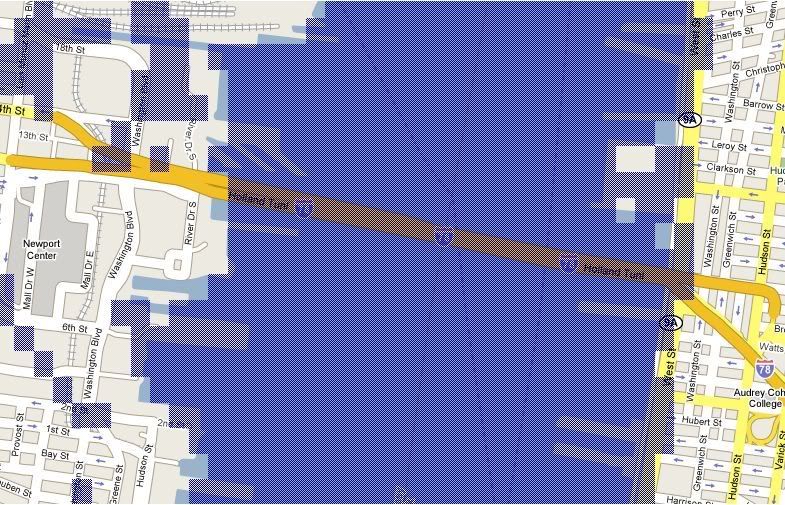
The Holland Tunnel

New York City Real Time Traffic Cameras
http://nyctmc.org/xmanhattan.asp
The Civil Engineering Portal - Landmarks - Tunnels - Holland
http://www.icivilengineer.com/Landmarks/Tunnels/Holland/
Holland Tunnel (I-78)
http://www.nycroads.com/crossings/holland/
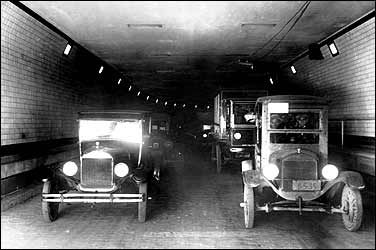
Looking Back: A way under the river
http://www.nj.com/news/index.ssf/2007/11/looking_back_a_way_under_the_r.html
On Nov. 14, 1927, motorists lined the bank of the Hudson River in Jersey City, hoping to be the first to travel to Manhattan via a breathtaking route that cut deep beneath the river's mighty currants.
The Holland Tunnel opened precisely at midnight to roaring cheers and baying horns. It was hailed as an engineering marvel.
The construction began simultaneously on the New Jersey and New York sides. Moving about 40 feet a day, a pair of hydraulically powered cast iron shields burrowed through the dirt and rock. Workers -- nicknamed sandhogs -- moved through a series of air locks to clear rubble and make room for iron rings supporting the tunnel walls. During seven years of construction, 17 workers died.
The chief challenge was ventilating the tunnel and protecting motorists from being chocked to death by the exhaust of their own vehicles. The solution was a revolutionary two-duct air exchange system -- one duct to pull in fresh air, the other to expel exhaust -- that became the prototype for automotive tunnels world over.
Nearly 52,000 vehicles drove through the tunnel on opening day, each paying a 50 cent toll, which was supposed to defray the tunnel's $48 million price tag. And they have been rolling -- but usually crawling -- through ever since.
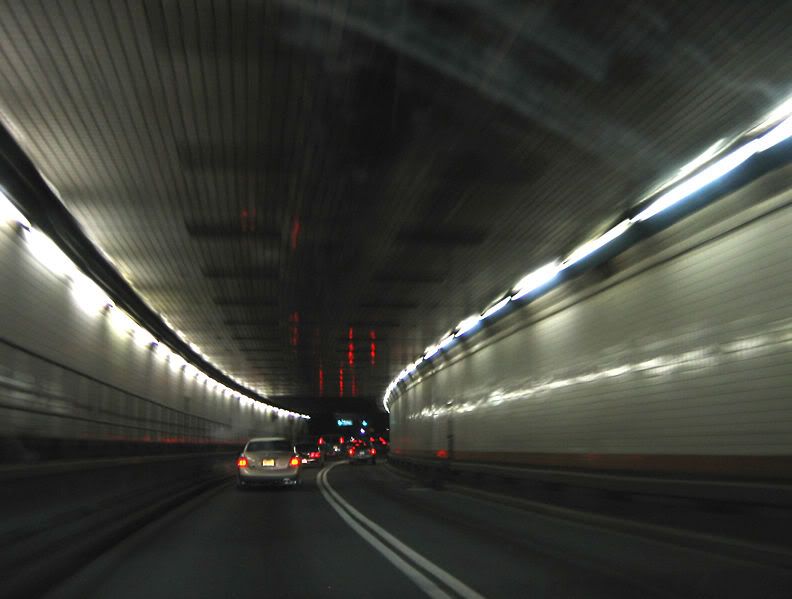
Holland Tunnel
http://www.time.com/time/magazine/article/0,9171,786201,00.html
President Coolidge stretched forth his arm to touch the golden lever of the presidential telegraphic instrument. He pressed, and a current of electricity flowed to Manhattan and directly across the Hudson river to Jersey City. At each place, in sight of thousands of crowding spectators, the current caused a pair of great U. S. flags slowly to separate. The Holland Vehicular Tunnel officially became open for inspection.
The spectators propelled themselves as speedily as possible into its white tiled maw. Seven hours later, at one minute after midnight, the motor vehicles for which the tunnel was built began to pass through from the New York and the New Jersey sides. In the second motor car to pay its toll fee*was Mrs. Clifford Milburn Holland, whose husband died as chief engineer of the tunnel. With her was Mrs. Milton H. Freeman, whose husband also died as chief engineer.
The Tunnel. The Holland Vehicular Tunnel consists of two tubes made of cast iron rings 29 ft. 6 in. in external diameter and lined with concrete. Other statistics:
Length† ....................................................9.250 ft.
Distance between portals ...................... 8,463 ft.
Length under river ...................... 5,480 ft.
Number of roadways ........................................ 2
Roadway width ..........................................20ft
Headroom ..........................................13½ft
Hourly vehicle capacity ..................................... 3,800
Maximum daily capacity ................................... 46,000
Yearly capacity .................................................. 15,000,000
Excavation ................................................... 500,000 cu. yd.
Cost .................................................................... $48,400,000
The Holland Tunnel's greatest problem was not its construction, but its ventilation—how to avoid the poisonous carbon monoxide gas exhausted from motor trucks and cars. Ventilation experiments at Yale, the University of Illinois and the U. S. Bureau of Mines showed that more than four parts of the gas in 10,000 of air was dangerous. To prevent disaster absolutely Chief Engineer Holland installed 84 ventilating fans in four 10 story buildings, two on each side of the Hudson. Part of them blow fresh air into the tunnel floor through vents, others suck vitiated air through ducts in the tunnel ceiling. Thus they change the tunnel air completely 42 times an hour and but 56 of the fans are needed to do so. Fire hazard is prevented by watchmen stationed every few score feet; and there are tunnel fire engines at each entrance.
The Builder. The states of New York and New Jersey named the tunnel after Clifford Milburn Holland. In 1906, when he was 23, he left Harvard with both A. B. and B. S. degrees. At once he went to Manhattan, saying: "I am going into tunnel work and I am going to put a lot more into it than I'll ever be paid for." In his early 30's he was building simultaneously four street railway tunnels under the East River, between Manhattan and Brooklyn.
Over the Hudson River, on the other side of Manhattan, there is no bridge. Ferries, lighters and under-river railroads carry the traffic. A few years ago there was an ice jam in the river and Manhattan lacked coal although there were heaps on the New Jersey side. That situation finally induced the two state legislatures to order the tunnel built. Their tunnel commissions chose Holland's plans and made him chief engineer. His wife last week told how he worked: "Evening after evening he remained at work. Our dinner hour was always uncertain. If we induced him to attend the theatre, he always went back to the tunnel afterward, spending hours in the field offices and personally supervising the work." It exhausted him and he died, 1924, of heart failure. The states made his tunnel a horizontal shaft over his memory.-
*Fifty cents for a car, 25 cents for a motorcycle, up to two dollars for a heavy truck. †About 1¾mi., longest of its kind in the world. Under the River Thames, at London, are Blackwall and Rotherhithe Tunnels, each 1¼ mi. long. Other important underwater vehicular tunnels are at Glasgow and Hamburg. The longest tunnel in the world, regardless of purpose, is the Shandaken Tunnel in New York State—28.l mi. It carries water to the Ashokan Reservoir.
*New York City has named the Plaza before its tunnel entrance Freeman Square, after Milton H. Freeman, who succeeded Holland as chief engineer and died four months after him. The chief engineer who completed the job is 45-year-old Ole Singstad.
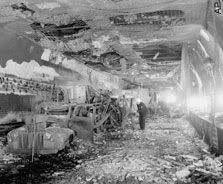
The Holland Tunnel fire
The Holland Tunnel fire occurred on the morning of Friday, May 13, 1949, in a hazardous materials truck passing through the Holland Tunnel under the Hudson River between New York and New Jersey.
http://www.answers.com/topic/holland-tunnel-fire
Timeline
At 8:30 a.m. a truck carrying eighty 55-gallon drums of carbon disulfide entered the south tunnel at the New Jersey portal. At the time, it was forbidden to carry carbon disulfide through the tunnel.
After the truck had traveled east for approximately 2900 feet (880 meters) in heavy traffic, one of the drums broke free of its restraints, fell onto the roadway and cracked open. Vapor released from the drum was ignited when it came into contact with a hot surface, probably a brake or exhaust (carbon disulfide vapor ignites when raised to a temperature of 194°F / 90°C).
The truck came to rest in the left (fast) lane of the tunnel on a 0.25% downgrade and began to burn. Vehicles unable to pass the fire came to rest in the right lane, blocking the tunnel completely as their drivers sought to escape on foot. The tunnel west of the fire became gridlocked with traffic.
Port of New York Authority patrolmen in the tunnel east and west of the truck radioed in to advise of the blockage (8:48 a.m.) then to advise of the fire (8:56 a.m.). They assisted drivers to escape to the north tunnel through cross-passages. Tunnel staff entered the New Jersey portal to evacuate the occupants there and started to reverse vehicles out, while a works brigade crew drove the wrong way along the south tunnel and began fighting the fire at the site of the truck where it started.
Jersey City Fire Department were alerted at 9:05 a.m., New York Fire Department were alerted at 9:12 a.m.
The New York rescue crew set up a command post in the north tunnel at a cross passage near to the fire. They relieved the works brigade and sent a "make pumps 9" alarm at 9:30 a.m.
When the Jersey City crews arrived at the tunnel portal, they also sent requests for more firefighters and for oxygen breathing equipment.
Hot smoke caused a second fire to start, in a group of trucks apparently carrying paint and turpentine approximately 350 feet (110 m) west of the original fire. After this, the tunnel ventilation system was turned to full extract & full supply in order to extract smoke and reduce the likelihood of other spontaneous ignitions.
New Jersey firemen succeeded in extinguishing the second fire, and cleared a path for brigade vehicles to the first fire site where they linked up with the New York firemen. By 1:00 p.m. the fire was surrounded, and despite a re-ignition at 6:50 p.m. the stop message was issued at 12:52 a.m. the next morning.
The wreckage was cleared up and the tunnel re-opened to traffic on the evening of Sunday, May 15.
Emergency Response
At the time of the fire, the Holland Tunnel was operated by the Port of New York Authority, which had control of various other transportation facilities in the area as well. Consequently, they had a works fire brigade nearby, who initiated firefighting operations at the seat of the fire about five minutes after it started.
New Jersey and New York fire brigades called up 29 firefighting trucks of varying types and borrowed four more trucks with breathing appparatus from Consolidated Edison. In total there were about 63 emergency response vehicles (including police, medical units, port authority vehicles and brigade supervisory vehicles).
The tunnel firemain (a 6 inch water pipe cast directly into the secondary concrete lining) continued to function throughout the fire.
Tunnel ventilation
At 9:45 a.m. the tunnel ventilation system was turned to full extract and full supply in the zone of the fire (zone S4). The supply of air through the duct under the roadway enabled firefighters to work without masks (by taking breaths from the air coming through the supply flues at curb level). The extract duct above the roadway captured some of the smoke and when the false ceiling at the site of the fire collapsed, a hole formed between the road tunnel and the extract ventilation duct: this hole dramatically improved the capture of smoke at the main fire site, though it reduced smoke capture at the second fire site to practically nothing.
Two of the extract fans in the New Jersey River vent shaft failed due to the heat of the fire (the shaft was approximately 300 feet (100 m) west of the fire, and was apparently drawing air at 1000°F / 540°C). The third fan was kept in working order by cooling it with a water spray.
Injuries and Damage
In total, 66 people were injured, mostly by smoke inhalation. Of these, 27 were hospitalized. One firefighter (Battalion Chief Gunther E Beake) was severely affected by smoke inhalation and died of his injuries on 23 August 1949.
The truck carrying carbon disulfide was completely destroyed, as were nine other trucks. 13 trucks were damaged.
The infrastructure suffered extensive damage. Approximately 650 short tons (590 tonnes) of rubble were removed during the weekend before the tunnel reopened.
The tiles on the tunnel walls spalled off for a distance of approximately 200 feet (60 meters) west of the fire site and 500 feet (150 meters) east of it. At the site of the fire, the concrete lining of the walls spalled down to the ribs of the cast-iron primary lining.
The false ceiling above the roadway (which consisted of a 6 inch-thick, insitu, reinforced concrete slab) collapsed completely in several places and collapsed partially over a length of approximately 500 feet (150 meters).
The elevated side walkway had to be renewed over a length of 750 feet (230 meters), and the cable ducts cast into the walkway and walls were replaced over 300 feet (90 meters).
Damaged power cabling, communications cabling and lighting were all renewed over the damaged area. The road surface was renewed over a length of about 500 feet (150 meters).
The Port Authority decided that the tunnel could not be closed completely for the duration of the reconstruction. Instead, the south tube was closed at 8 p.m. each night, after which hundreds of feet of mobile scaffold and other equipment was hauled in. Reconstruction work was carried out overnight until approximately 4:30 a.m., at which time the construction equipment and scaffold was hauled out before the tunnel re-opened at 6 a.m. The repairs were completed by mid-August 1949. During the period of reconstruction, an unknown number of hats were sucked out through the broken extract duct, and expelled out of the New Jersey River vent shaft.
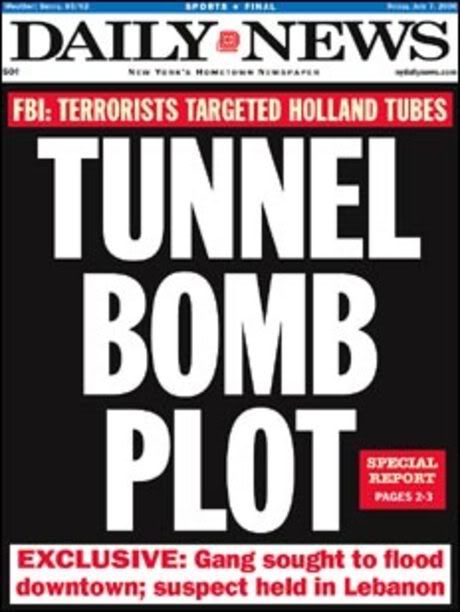
Terror Plotters Planned to Bomb NYC's Holland Tunnel, Say Officials
The Plot Was Reportedly Inspired by Flooding in New Orleans, but Badly Flawed
http://abcnews.go.com/GMA/story?id=2163524
Since Sept. 11, 2001, authorities have feared New York's tunnels or bridges could be targets for terrorists.
The Holland Tunnel -- linking lower Manhattan and New Jersey -- is one of four major tunnels into the city. More than 34 million cars and trucks pass through it every year -- clearly a tempting target for terrorists.
The plotters, described as jihadists, wanted to atack the tunnel with high explosives, according to a report in the New York Daily News, quoting FBI sources.
A suspect has been arrested in Lebanon, officials told ABC News.
A Justice Department official confirmed to ABC News the basics of the alleged plot, but said the planning was in its initial phases and mostly overseas. Officials do not believe there are links to plotters or operatives inside the United States.
Inspired by Katrina?
The Holland Tunnel plot apparently aimed to cause an explosion powerful enough to blast a hole in the tunnel. The plotters reportedly hoped to trigger a devastating flood in lower Manhattan, the city's financial center.
The idea to bomb the tunnel reportedly was inspired by the flooding in New Orleans caused by Hurricane Katrina.
Officials told the Daily News the alleged plot was more serious than the rag-tag plan by seven suspects in Miami to blow up the Sears Tower in Chicago and a federal building in Florida.
"This is more advanced than the Miami Seven," said one official quoted in the Daily News.
But an Army Corps of Engineers official told the newspaper the concept was badly flawed. The Holland Tunnel is not in the Hudson River, but in the bedrock beneath it. And the lowest part of downtown Manhattan is 10 feet above sea level.
The Daily News report says the plotters had appealed to Abu Musab al-Zarqawi, the Jordanian terrorist leader in Iraq killed last month.
The paper says Zarqawi promised money and assistance to the plotters, though it is unclear if they ever got it.
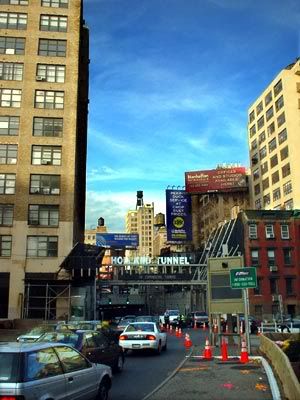
WEAK TUNNEL VISION
POLS RIP LACK OF RATINGS SYSTEM
http://www.nypost.com/seven/08062007/news/regionalnews/weak_tunnel_vision_regionalnews_jeremy_olshan_and_eric_lenkowitz.htm
The city's heavily trafficked tunnels are not required to be inspected every two years - as the state and federal governments mandate for bridges - and records of their upkeep have been spotty, officials charged yesterday.
"In the case of the tunnels, the absence of standards is a great concern. The tunnels are as critical as bridges are with regard to safety and the potential for degradation," said City Councilman John Liu (D-Queens), chairman of the Transportation Committee.
The Holland, Lincoln, Queens-Midtown and Brooklyn-Battery tunnels carry more than 350,000 cars in and out of Manhattan every day - and officials are concerned that the decades-old crossings do not get enough oversight.
"The Minnesota bridge collapse must be a wake-up call to overhaul our nation's transportation infrastructure, above ground and below," Sen. Charles Schumer told The Post.
It is currently up to the MTA and the Port Authority to regulate and inspect their own tunnels. Both agencies insist inspections are carried out every two years and the tubes are in good shape.
But there is no rating system in place as there is with the bridges, and lapses have been found.
As recently as 2004, then-state Comptroller Alan Hevesi blasted the PA's inspection program, saying several structural flaws were discovered and inadequate records were kept to support the agencies' claim that work had been done.
"Our follow-up review found that [the PA] did not have adequate internal control and record-keeping systems as they relate to the tunnel maintenance and inspection program," Hevesi wrote PA Chairman Anthony Coscia in 2004.
"At the Lincoln Tunnel, work orders could not be produced to substantiate the work reportedly performed, and at the Holland Tunnel, work orders were either incomplete or missing essential information."
The 2004 audit also found that the PA "has not repaired cited deficiencies for as long as six years after they were initially identified."
The bistate agency says it has corrected the problem, and, as of the most recent inspections, both the Holland and Lincoln tunnels are in good shape.
The MTA, which operates the Queens-Midtown and Brooklyn-Battery tunnels, said both crossings also passed their most recent inspections.
"At the moment we are in the process of inspecting the Queens-Midtown Tunnel and we will do the Brooklyn-Battery next year," MTA Bridges and Tunnels spokeswoman Catherine Sweeney said.
The agency is spending $69 million to improve the tunnels as part of its 2005-2009 capital plan.
It has slotted $52 million of that for the Brooklyn-Battery Tunnel - where the bulk of the work is needed, including renovating the ventilation system, electrical system, and control center.
Tunnel inspectors look for:
* Cracks and other flaws in the walls, roadways and ceiling surfaces.
* Leaks that surpass the maximum allowable rate and staining that could mean corrosion of reinforced steel.
* Any problems with the air flow through faulty ventilation.
* Shifts in the riverbed, which could place excess pressure on the roof.

Tunnel to the Future
http://www.americanheritage.com/places/articles/web/20071113-holland-tunnel-transportation-new-york-new-jersey-hudson-river-civil-engineering.shtml
One Saturday in the autumn of 1927, 20,000 pedestrians walked through the brand-new Holland Tunnel shouting and singing and listening to their voices echo off the glistening white-tile walls. President Calvin Coolidge and a throng of dignitaries had that day dedicated one of the engineering marvels of the age. Then, just past midnight on Sunday, November 13—80 years ago today—the tunnel opened for traffic. A delivery truck bound for Bloomingdale’s, the department store, was the first paying vehicle to pass through the longest underwater vehicular tunnel in the world.
Twenty-one years had passed since officials had begun to grapple with the problem of getting automobile traffic across the Hudson River. So many ferries and barges plied the mile-wide waterway that they threatened to disrupt the passage of large ships. A bridge had been talked about for decades, but a seven-year study begun in 1906 found the idea impractical. Manhattan lay too low; a huge tower with a long approach would have been needed. (The George Washington Bridge would open in 1931 ten miles north of the downtown hub, where the river carved through high land.)
Thoughts turned to tunnels. Engineers had bored a railroad tunnel under the river in 1910, but a tunnel to accommodate cars and trucks would need to be much larger. Even more daunting was the problem of clearing the tube of exhaust fumes. Studies on volunteers showed that extended breathing of as little as four parts of carbon monoxide in 10,000 of air could be harmful.
A design submitted by Clifford M. Holland, a young engineer who had worked on the New York City subway system, was chosen in 1919. The project would require digging two tunnels, one carrying cars in each direction.
The work, which got underway the next year, began with the sinking of four large shafts, two on shore and two into the river bottom. Workmen constructed caissons, boxes with walls five feet thick, towed them into the river, and sank them onto the silt below the water. They descended into these boxes while operators kept the inside air pressure high enough to keep them from flooding. Then they began to dig.
When they had dug down to tunnel level, about a hundred feet below the river surface, the sandhogs (as the workers in the caissons were called) began using powerful jacks to push huge iron shields into the silt. Again, compressed air kept the mud and water from seeping in. All people and materials had to enter the work area through air locks.
Some days the progress was measured in feet, and some days it slowed to inches, as the men hammered and blasted through solid rock. The work was dangerous—13 men died during the seven years of construction. Holland kept obsessively close watch on every detail. “When Clifford M. Holland talks tunnels,” the Brooklyn Daily Eagle wrote, “his listener is in danger of being convinced that tunnels are the only refuge for mankind.”
By the autumn of 1924, workers were on the verge of joining the 29-1/2-foot-wide cast-iron tubes reaching out from either side of the river. But Holland had put too much of himself into the project. He suffered a nervous breakdown and died of a heart attack less than two days before the “hole through.” He was 41. The tunnel was given his name a few weeks later.
Once the tubes were completed, workmen lined them with concrete and installed a granite roadbed. But the real innovation was the ventilation system. Shorter highway tunnels relied on air flowing through each end. Holland had determined that to keep his tunnel supplied with fresh air that way would require a wind of 75 miles an hour. Instead, he planned to bring fresh air in through ducts under the roadway and take away exhaust fumes through a passage above the ceiling, changing all the air in the tunnels every 90 seconds.
Four ventilation buildings housing 84 huge fans accomplished the task. The fans could be regulated according to the traffic level. Monitors were installed to check the carbon monoxide concentration. In the early years of operation, lights along the way signaled drivers to turn off their engines during any long delays.
Today, this project that required a heroic vision to undertake and impressive ingenuity to complete seems decidedly mundane. A hundred thousand vehicles roll through the Holland Tunnel every day. Drivers either take the great engineering achievement for granted or curse it as a bottleneck.
But as the collapse of the Interstate 35 bridge in Minneapolis in August graphically illustrated, such an attitude can be dangerously shortsighted. Americans have too often neglected one of the critical functions of any government, maintaining and improving the nation’s infrastructure.
“The fact is that Americans have been squandering the infrastructure legacy bequeathed to us by earlier generations,” wrote Stephen Flynn, a senior fellow at the Council on Foreign Relations, in a recent issue of Popular Mechanics. “Like the spoiled offspring of well-off parents, we behave as though we have no idea what is required to sustain the quality of our daily lives.”
Officials in 1913, when the tunnel was first authorized, recognized that steadily increasing motor traffic would require a serious expenditure of money—the tunnel cost around $50 million, the equivalent of $600 million today—and effort. Eighty years later, we continue to profit from their vision and their investment. The Holland Tunnel is a model of investment in infrastructure that works and can last.













![Brotherhood" (2006) [TV-Series]](http://photos1.blogger.com/x/blogger2/1421/379621144723082/211/z/425926/gse_multipart33129.jpg)







No comments:
Post a Comment